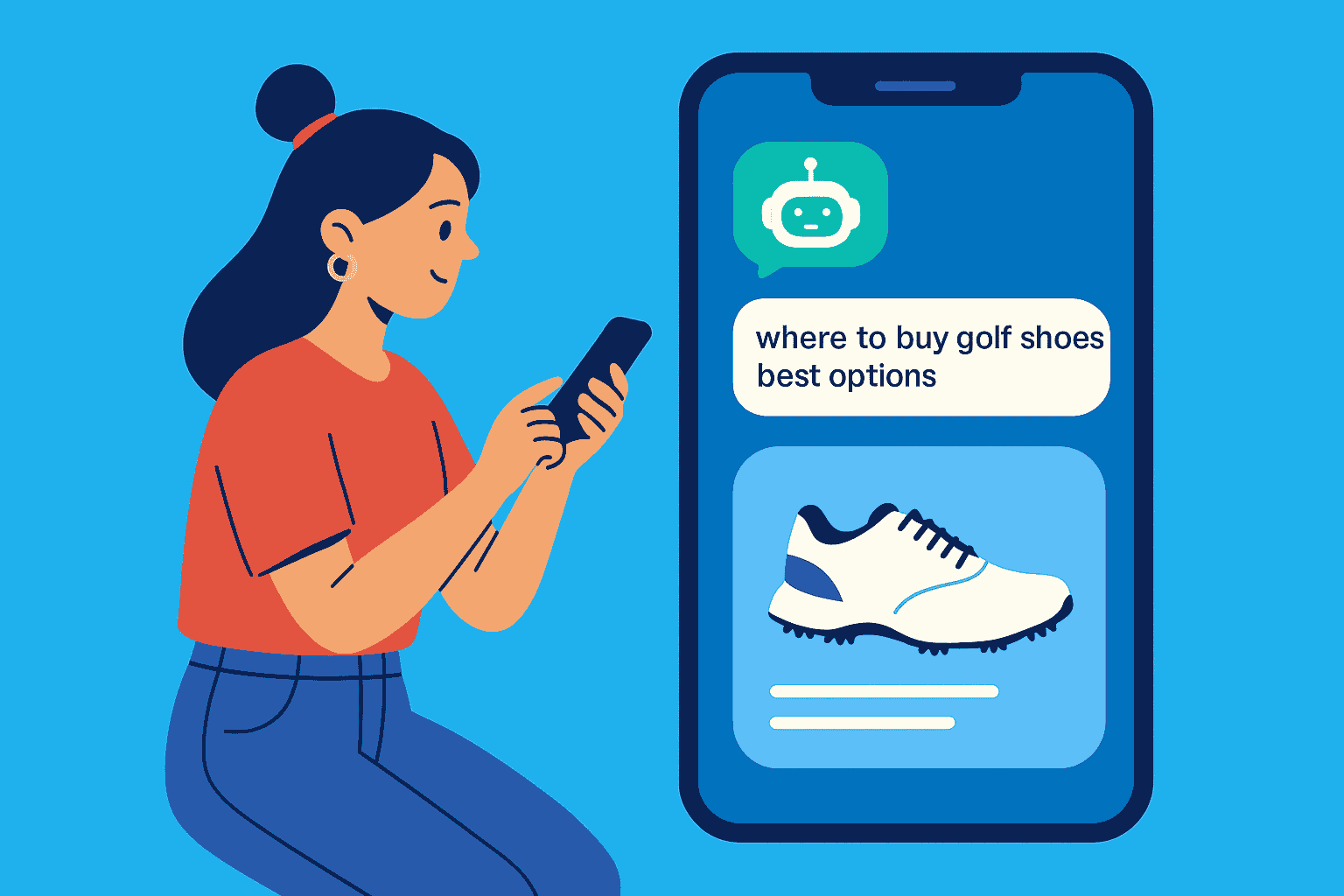Rank in AI Search: Ecommerce Marketing Guide (2026)

The ground is shifting beneath our feet, and most ecommerce leaders don't even realize it yet.
While we've been obsessing over traditional SEO rankings and Google's algorithm updates, a quiet revolution has been transforming how consumers discover and purchase products online. AI-powered search engines are now handling 13% of all global searches and 16% of U.S. desktop searches, with 47% of Gen Z using generative AI weekly. More critically, 65% of users are now finding answers without ever visiting external websites—what we call zero-click searches.
For ecommerce brands across all verticals—from electronics to home goods, fashion to beauty, and everything in between—this isn't just another trend to monitor. It's an existential threat that demands immediate strategic attention.
What’s covered in this detailed guide:
- What’s New in Ecommerce SEO: Product Discovery via AI Search Results
- Why Your Products Aren't Appearing in AI Search Results
- How to Optimize Ecommerce Product Listings for AI Search Visibility
- Content Strategy Changes to Optimize for AI Search
- Leveraging AI to Optimize Your Ecommerce Site for AI Search
- Top metrics for measuring success in AI-generated responses
What’s New in Ecommerce SEO: Product Discovery via AI Search Results
Traditional search worked like a library catalog—it pointed you to sources. AI search works like a knowledgeable curator who reads everything and gives you personalized recommendations. Perplexity's shopping assistant now offers one-click checkout directly within search results, while ChatGPT's upcoming product discovery feature promises to transform how consumers research purchases.
The implications for global ecommerce are staggering. When a consumer asks Perplexity, "What's the best wireless headphones under $200 for working out?" or "Which skincare routine works best for dry skin?" the AI doesn't just list websites—it analyzes product data, reviews, and pricing to provide specific recommendations with direct purchase paths. Brands that aren't optimized for these AI systems simply don't exist in this new paradigm.
Why Your Products Aren't Appearing in AI Search Results
Having analyzed thousands of product listings across ecommerce platforms globally, three critical failures emerge consistently across all verticals:
1. Missing Schema Markups
Most ecommerce brands treat structured data as an afterthought. When listing a product, they might have a compelling product title and beautiful imagery, but their schema markup tells a different story. AI systems like Perplexity and ChatGPT rely on machine-readable signals—product schema, offer markup, and organization data—to understand what you're selling.
The Reality Check: While major retailers have successfully used AI for trend prediction and inventory management, many smaller brands still lack basic product schema implementation.
2. The Shallow Content Problem
Consider this typical product description from a jewellery brand:
"Beautiful gold-plated earrings. Premium quality. Perfect for parties."
Now compare it to an AI-optimized version:
"Handcrafted Gold-Plated Chandelier Earrings - Statement Drop Earrings, 3-inch length, hypoallergenic for sensitive ears, perfect for evening events and special occasions. Features intricate filigree work and secure lever-back closure."
The difference? The second description answers the questions AI systems need to match products with search intent, regardless of your product category.
3. Poor Trust Signal
AI systems prioritize products with authentic reviews and verified purchase data. When an AI engine encounters conflicting information—one listing with 200 detailed reviews and another with 10 generic ones—the choice is obvious across any product category.
How to Optimize Ecommerce Product Listings for AI Search Visibility

1. Implement Comprehensive Schema Markup
Start with JSON-LD structured data for every product. Here's an example of what a properly optimized product listing should include:
json
{
"@context": "https://schema.org",
"@type": "Product",
"name": "Sterling Silver Diamond Accent Tennis Bracelet",
"description": "Elegant sterling silver tennis bracelet featuring genuine diamond accents. Perfect for weddings, anniversaries, and formal occasions. Secure box clasp with safety chain.",
"brand": {
"@type": "Brand",
"name": "Luxury Jewelry Co"
},
"gtin": "8901234567890",
"mpn": "LJC-TB-001",
"offers": {
"@type": "Offer",
"price": "299.99",
"priceCurrency": "USD",
"availability": "https://schema.org/InStock",
"seller": {
"@type": "Organization",
"name": "Luxury Jewelry Co"
}
},
"aggregateRating": {
"@type": "AggregateRating",
"ratingValue": "4.7",
"reviewCount": "156"
}
}
2. Optimize Product Titles for Conversational Search
Consumers increasingly search conversationally across all categories. Your product titles must bridge this gap between how people think and speak versus how they traditionally searched.
Before: "Blue Dress - Size M"
After: "Professional Navy Blue Midi Dress for Office Wear - Medium, Wrinkle-Resistant Fabric"
3. Create Rich, Intent-Focused Descriptions
Transform your product descriptions into comprehensive guides that answer the who, what, when, where, and why questions AI systems need.
For example, for a fashion brand, instead of basic material details, include:
- Occasion appropriateness (office, casual, formal)
- Styling suggestions and compatibility
- Care instructions and durability
- Sizing and fit guidance
4. Robot.txt Updates for AI Crawlers
Ensure your robots.txt explicitly welcomes AI bots across all major platforms:
User-agent: GPTBot
Allow: /
User-agent: OAI-SearchBot
Allow: /
User-agent: PerplexityBot
Allow: /
User-agent: ClaudeBot
Allow: /
5. Make Website faster for AI Crawlers with SERA-GPT
Most ecommerce sites rely heavily on JavaScript for product displays, pricing, and reviews. AI crawlers often can't process JavaScript-generated content, seeing only empty pages. Implement server-side rendering or prerendering solutions like SERA-GPT to ensure AI bots see your complete product information.
6. Direct Submission to AI Platforms
- Perplexity already offers a merchant program for retailers to submit product catalogs directly, ensuring listings don't rely solely on bot crawling.
- OpenAI is developing a similar product feed submission system for ChatGPT shopping results.
Content Strategy Changes to Optimize for AI Search
1. FAQ Schema Implementation
Different product categories have specific questions consumers ask. Implement FAQ schema addressing common queries in your vertical.
For Example:
- "Is this suitable for sensitive skin?"
- "What occasions is this appropriate for?"
- "How should I style this?"
- "What's the return policy for sizing issues?"
2. Review Strategy Optimization
AI systems heavily weight authentic customer reviews and ratings when making recommendations. Develop a systematic approach to collecting detailed, helpful reviews that include specific use cases and detailed feedback.
3. Visual Search Readiness
Perplexity is developing an AI try-on feature for clothing visualization, while "Snap to Shop" already allows users to photograph items and find similar products. Ensure your product images include:
- Multiple angles and contexts
- Descriptive filenames (not IMG_001.jpg)
- Comprehensive alt text
- Lifestyle shots showing products in use
Leveraging AI to Optimize Your Ecommerce Site for AI Search
One of the smartest strategies for AI-friendly optimization is using AI tools in your content creation process. Many successful ecommerce brands now use AI to write product titles and descriptions that are keyword-rich, engaging, and optimized for AI understanding.
Here are strategic prompt frameworks you can use with ChatGPT or other AI platforms:
1. Product Title Optimization Prompt: "Create a descriptive, SEO-optimized product title for a [product type]. Include the primary keywords [main keyword] and [secondary keyword], highlight the key feature [unique feature]. Keep it under 80 characters and make it compelling for both search engines and shoppers."
Example Output: "Boho Vintage Gold Layered Chain Necklace - Adjustable Statement Jewelry"
2. Feature Bullet Points Prompt: "Create 5 compelling bullet points for a [product category] that highlight functional benefits, use cases, and key features. Focus on what customers actually care about when making a purchase decision."
Example for a Designer Handbag:
• Genuine Italian leather construction with hand-stitched details
• Spacious main compartment fits laptop up to 15 inches
• Multiple interior pockets for organized storage
• Adjustable shoulder strap (30-45 inches) for crossbody or shoulder wear
• Professional design perfect for work, travel, or daily use
3. Tone and Style Adjustment Prompt: "Rewrite this product description in a [desired tone] tone for [target audience]. Include key phrases [phrase1] and [phrase2] naturally, ensure 6th-grade reading level for accessibility."
4. Competitive Differentiation Prompt: "Help me position [Product] against competitors in one paragraph. Emphasize unique value propositions like [better materials/longer warranty/affordable price] without naming competitors. Position as the top choice for [specific use case]."
Example Output: "Unlike mass-produced alternatives, this handcrafted silver jewellery features individually selected gemstones and traditional metalworking techniques passed down through generations. Each piece undergoes rigorous quality testing and comes with a lifetime warranty, making it the perfect choice for customers seeking authentic, heirloom-quality jewellery at accessible prices."
Top metrics for measuring success in AI-generated responses
Traditional metrics like organic traffic and search rankings become less relevant when 65% of searches result in zero clicks to external websites. Focus on:
- AI Citation Frequency: Track how often your products appear in AI-generated recommendations across platforms
- Conversion Quality: AI-driven traffic typically shows higher purchase intent and conversion rates
- Voice Share: Monitor brand mentions across AI platforms for awareness metrics
- Direct Sales Attribution: Measure transactions originating from AI search platforms
- Product Discovery Rate: Track how quickly new products get indexed and recommended by AI systems
The Competitive Reality Check
Currently, 62% of SEO professionals report that AI search drives less than 5% of their revenue. But this isn't an indication of failure—it's a massive opportunity for early movers. The brands winning in AI search today will have insurmountable advantages as adoption accelerates.
Consider this: 91% of leadership teams are already asking about AI search visibility, indicating this transition is moving faster than performance metrics suggest. The window for gaining first-mover advantage is closing rapidly.
Major platforms are already adapting. Amazon has integrated agentic AI into its "Buy for Me" shopping tool, while Google's AI Overviews now appear in 13% of searches globally. Ecommerce brands that wait for "proven ROI" will find themselves competing for visibility in an AI-dominated landscape where the early movers have already captured consumer attention.
Adapt or Become Invisible?
The brands that win in the AI-first commerce landscape won't be those with the biggest advertising budgets or the most inventory. They'll be the ones that make it effortless for AI systems to understand, trust, and recommend their products.
This isn't about replacing your existing SEO strategy—it's about expanding it to include the new AI-powered gatekeepers that increasingly determine product discovery. The technical implementation is straightforward, but the strategic advantage goes to brands that act decisively.
The AI revolution isn't coming. It's here. And it's rewriting the rules of ecommerce discovery one search at a time.
Every day you delay optimization is a day your competitors gain ground in the algorithms that will determine tomorrow's market leaders. The question isn't whether to optimize for AI search—it's how quickly you can implement comprehensive strategies before the window of opportunity closes.

![Run an AI SEO Audit [FREE CHECKLIST]](https://www.n7.io/cdn.prod.website-files.com/61779da08a0e587b4ac301a6/68cd27e0e00e3ddbe46c73d2_AI%20Seo%20audit%20banner.png)

.png)
